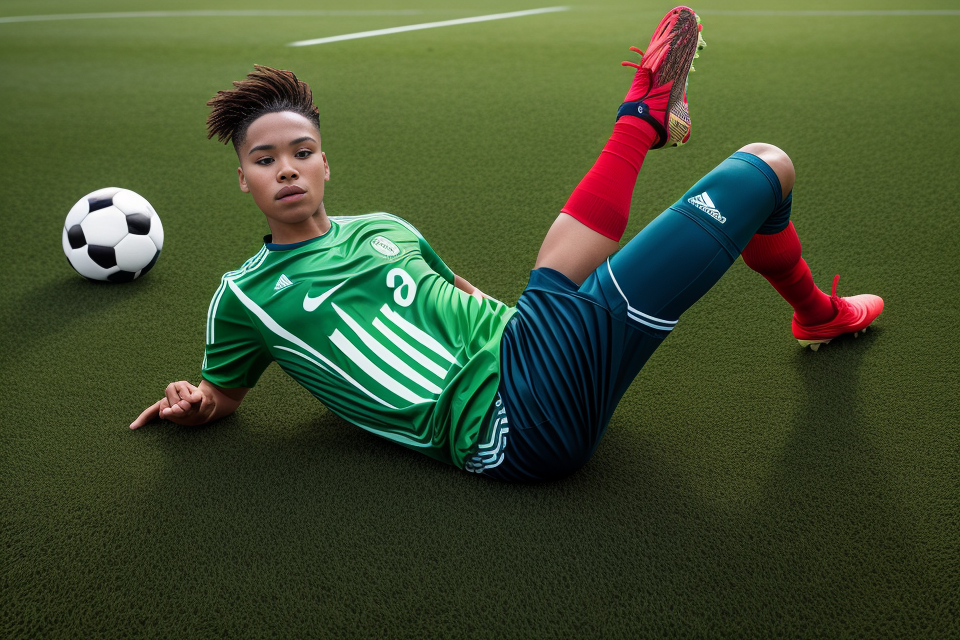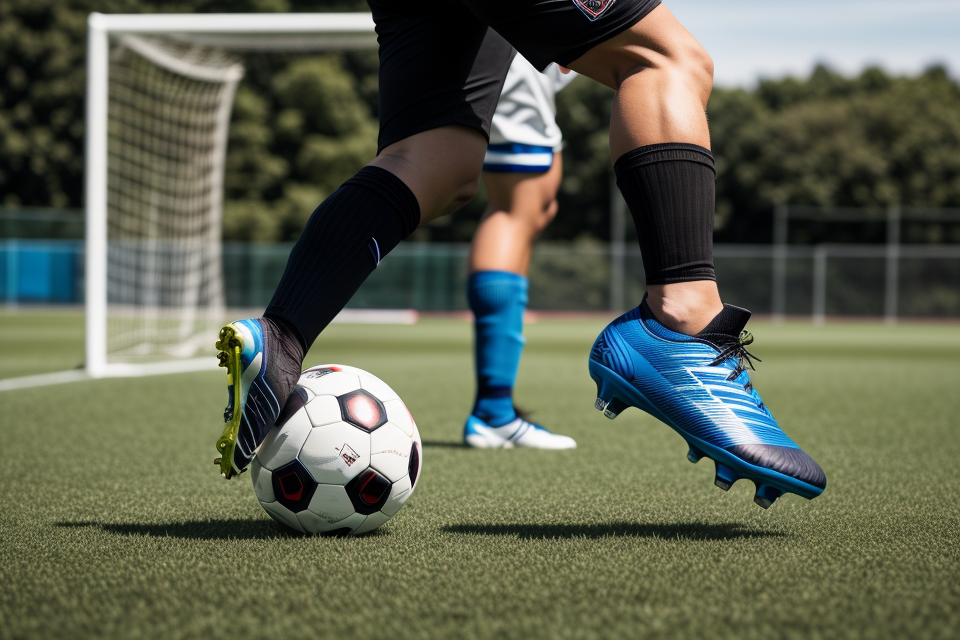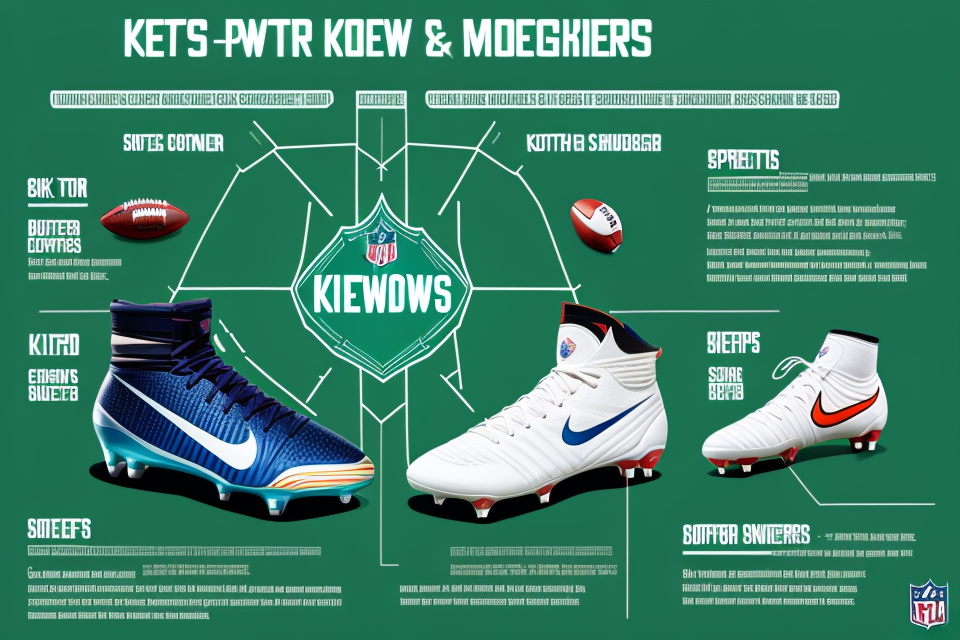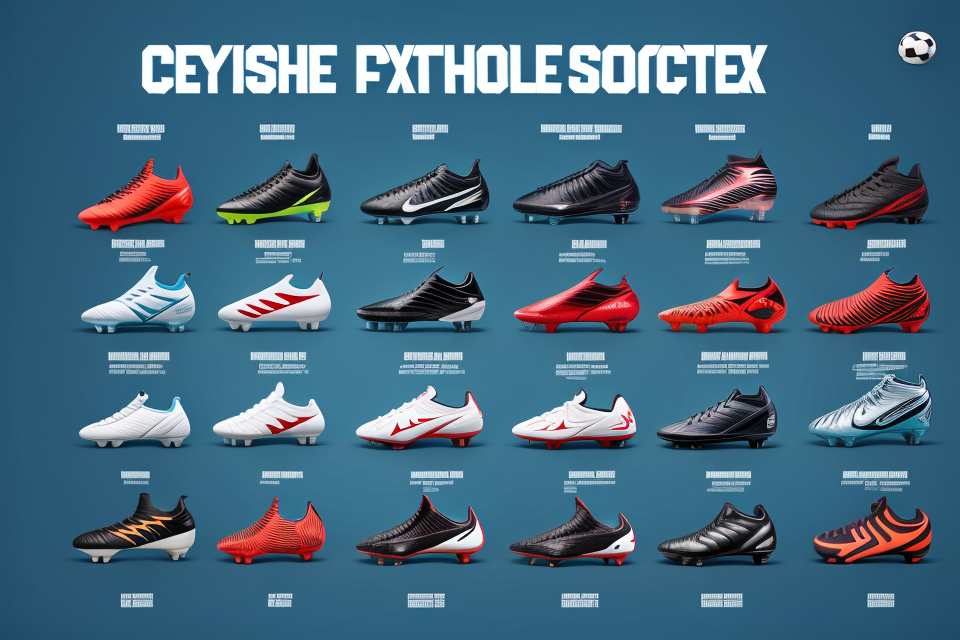Soccer is a sport that requires speed, agility, and quick reflexes. The game is played on a variety of surfaces, including grass, turf, and artificial turf, and the type of shoes you wear can make a big difference in your performance on the field. That’s why soccer cleats are essential for optimal performance. In this article, we’ll explore why soccer cleats are so important and what features to look for when choosing the right pair for your game.
Soccer cleats are essential for optimal performance on the field because they provide the necessary traction and support for players during quick changes of direction and high-speed movements. The specialized design of soccer cleats, with their firmly attached studs or blades, allows for better grip on the field, reducing the risk of slips and falls. This improved stability and control helps players to maneuver more effectively, making it easier to change direction, stop or start quickly, and maintain balance while running at high speeds. Additionally, soccer cleats often offer better support for the ankle, which can help prevent injuries and improve overall performance. All of these factors combined make soccer cleats an indispensable tool for any serious soccer player looking to achieve optimal performance on the field.
Understanding Soccer Cleats
The Anatomy of Soccer Cleats
Soccer cleats are designed to provide optimal support, traction, and comfort to soccer players during a game. Each component of the cleat plays a crucial role in enhancing the player’s performance on the field. In this section, we will explore the different parts of soccer cleats and their functions.
Outsole
The outsole is the bottom part of the cleat that comes into contact with the ground. It is typically made of rubber or other durable materials and features small spikes or blades that provide traction and stability on different surfaces. The design of the outsole varies depending on the type of cleat and the playing surface. For example, cleats designed for artificial turf typically have shorter and more numerous blades compared to those designed for natural grass.
Midsole
The midsole is the layer between the outsole and the upper part of the cleat. It provides cushioning and support to the foot and helps absorb impact from running and jumping. Some cleats feature a removable insole that can be replaced with custom orthotics to better support the player’s unique foot shape and needs.
Upper
The upper is the part of the cleat that covers the foot and is typically made of synthetic materials such as polyurethane or leather. It is designed to provide a snug fit around the foot and ankle, allowing for maximum control and support during play. The upper may also feature different textures or patterns to enhance grip and ball control.
Lacing system
The lacing system is what secures the upper to the foot and allows for adjustment of the fit. Different cleats may have different lacing systems, such as a traditional lace-up system or a zip or velcro closure. The lacing system should be chosen based on the player’s preference and the fit of the cleat.
Insole
The insole is the part of the cleat that comes into contact with the foot. It provides cushioning and support to the foot and can be made of different materials such as foam or gel. Some cleats feature a removable insole that can be replaced with custom orthotics to better support the player’s unique foot shape and needs.
In conclusion, each component of soccer cleats plays a crucial role in enhancing the player’s performance on the field. The outsole provides traction and stability, the midsole provides cushioning and support, the upper provides control and support, the lacing system allows for adjustment of the fit, and the insole provides cushioning and support to the foot. By understanding the anatomy of soccer cleats, players can choose the right cleats for their specific needs and enhance their performance on the field.
Types of Soccer Cleats
When it comes to soccer cleats, there are four main types, each designed for specific playing surfaces. Understanding the differences between these types of cleats can help players choose the right cleats for their needs and optimize their performance on the field.
- Firm Ground (FG) Cleats are designed for playing on natural grass fields. They have a short, firm and pointed studs that provide excellent traction and stability on firm, dry surfaces. These cleats are suitable for most outdoor soccer games and are the most common type of cleats used by players.
- Soft Ground (SG) Cleats are designed for playing on soft, wet or muddy fields. They have longer and more flexible studs than FG cleats, which allow players to maintain their footing on soft and unstable surfaces. SG cleats are ideal for playing on fields that are muddy or have been watered before the game.
- Artificial Ground (AG) Cleats are designed for playing on artificial turf fields. They have a smaller and harder studs than FG cleats, which provide excellent traction on hard and slippery surfaces. These cleats are suitable for playing on indoor or outdoor artificial turf fields.
- Indoor Soccer Cleats are designed for playing on indoor surfaces such as gyms or sports halls. They have a flat sole and no studs, which make them ideal for playing on smooth surfaces such as gym floors or basketball courts. These cleats provide excellent grip and control on indoor surfaces and are ideal for playing indoor soccer games.
It’s important to note that choosing the right type of cleats can have a significant impact on a player’s performance on the field. Players should consider the type of surface they will be playing on, as well as their own personal preferences and needs when choosing the right cleats for them.
Benefits of Wearing Soccer Cleats
Improved Traction and Support
Firm Ground (FG) Cleats
Firm ground (FG) cleats are designed for playing on natural grass fields. The blades of the cleats are made of a durable material that grips onto the grass, providing the player with better traction and control. The blades are also slightly raised, which helps to prevent the ball from slipping away when it comes into contact with the cleats. This design allows for quick changes of direction and the ability to make accurate, powerful shots.
Soft Ground (SG) Cleats
Soft ground (SG) cleats are specifically designed for playing on fields with soft or muddy conditions. The cleats have a wider, longer blade than FG cleats, which helps to prevent the player from sinking too deeply into the soft ground. The cleats also have a series of small, flexible rubber studs that provide better grip on the ground, making it easier to change direction and maintain control of the ball.
Artificial Ground (AG) Cleats
Artificial ground (AG) cleats are designed for playing on artificial turf fields. The cleats have a series of small, conical or bladed studs that are firmly attached to the sole of the shoe. These studs provide excellent traction on the artificial surface, allowing the player to make quick changes of direction and maintain control of the ball. The cleats also have a reinforced sole that provides extra support and protection for the player’s foot.
In conclusion, soccer cleats are essential for optimal performance on the field as they provide improved traction and support for the player. Firm ground, soft ground, and artificial ground cleats are all designed for specific playing conditions, and each provides different benefits to the player. Whether it’s gripping onto natural grass, preventing sinking into soft ground, or providing traction on artificial turf, soccer cleats are an essential part of any player’s equipment.
Enhanced Performance and Control
Wearing soccer cleats provides several benefits that can enhance a player’s performance and control on the field. One of the most significant advantages is the improved control and traction that cleats offer.
Lightweight materials
Soccer cleats are made from lightweight materials such as synthetic leather and mesh, which allows for greater flexibility and mobility. This enables players to move quickly and change direction rapidly, essential skills for success on the field.
Design features
The design of soccer cleats also plays a crucial role in enhancing performance and control. Many cleats feature conical or bladed studs that provide excellent traction on different types of playing surfaces. These studs are strategically placed to offer support and stability while turning, accelerating, or decelerating.
Additionally, some cleats have a raised texture or ridges on the sole that improve grip and control on the ball. This helps players maintain close control during dribbling and passing, which is crucial for successful ball possession and distribution.
Flexibility and support
Soccer cleats are designed to provide both flexibility and support, which is essential for optimal performance. The materials used in their construction, such as synthetic leather and mesh, allow for a snug fit that supports the foot’s natural movement.
The design of the cleats also promotes flexibility by incorporating a flexible sole that bends and conforms to the shape of the foot. This allows for natural movement and improved agility, which is crucial for quick changes of direction and explosive acceleration.
Moreover, the support provided by soccer cleats helps prevent injuries by offering stability to the foot and ankle during high-impact movements, such as jumping and landing. This support also helps in maintaining proper foot alignment and posture, which is essential for accurate shooting and passing.
Overall, wearing soccer cleats is essential for optimal performance and control on the field. The combination of lightweight materials, design features, and flexibility and support provides players with the necessary tools to excel in their game.
Protection and Comfort
Padding and Cushioning
One of the primary reasons why soccer cleats are essential for optimal performance on the field is due to their ability to provide padding and cushioning to the feet. Soccer players are constantly on the move, running, jumping, and changing direction at high speeds. This constant physical activity can lead to fatigue and discomfort, which can negatively impact performance. The padding and cushioning in soccer cleats help to absorb the impact of each step, reducing the strain on the feet and providing a more comfortable experience for the player.
Durability and Longevity
Another benefit of wearing soccer cleats is their durability and longevity. Soccer cleats are designed to withstand the rigors of the game, and they are made with high-quality materials that can withstand the wear and tear of regular use. The durability of soccer cleats means that players can focus on their performance without worrying about their shoes falling apart or wearing out too quickly.
Arch Support
Finally, soccer cleats provide arch support, which is essential for maintaining proper foot alignment and preventing injuries. The arch support in soccer cleats helps to distribute the weight of the body evenly across the feet, reducing the risk of foot pain and injuries such as plantar fasciitis. Additionally, the arch support in soccer cleats can help to improve balance and stability, which is crucial for performing at an optimal level on the field.
Choosing the Right Soccer Cleats
Factors to Consider
When selecting the right soccer cleats, there are several factors to consider to ensure optimal performance on the field.
Your Playing Style
Your playing style is a crucial factor to consider when choosing soccer cleats. For instance, if you are a player who likes to make quick changes of direction and move rapidly, you may benefit from cleats with a soft and flexible sole that provides excellent grip on the field. On the other hand, if you are a player who likes to make long passes and plays, you may benefit from cleats with a firm and sturdy sole that provides excellent accuracy and control.
Field Conditions
The field conditions are another essential factor to consider when choosing soccer cleats. For instance, if you play on a wet and muddy field, you may benefit from cleats with a rugged sole that provides excellent traction on the field. If you play on a dry and hard field, you may benefit from cleats with a hard and durable sole that provides excellent support and stability.
Budget
Your budget is also an essential factor to consider when choosing soccer cleats. While expensive cleats may provide excellent performance, they may not be necessary for all players. Therefore, it is crucial to find a balance between performance and affordability when selecting soccer cleats.
In conclusion, when choosing soccer cleats, it is crucial to consider several factors, including your playing style, field conditions, and budget. By taking these factors into account, you can select the right soccer cleats that will provide optimal performance on the field.
Size and Fit
Properly fitting soccer cleats are essential for optimal performance on the field. When choosing the right soccer cleats, it is important to consider the size and fit.
Measuring your foot
The first step in finding the right size soccer cleats is to measure your foot. To do this, measure the length and width of your foot using a measuring tape or a ruler. It is important to measure your foot while wearing the same socks that you will be wearing during the game. This will ensure that the cleats fit comfortably and provide the necessary support.
Sizing charts
Once you have measured your foot, you can use a sizing chart to determine the right size of soccer cleats. Sizing charts are typically provided by the manufacturer and are based on the length and width of your foot. It is important to use a sizing chart that corresponds to the brand and model of soccer cleats you are considering.
Breaking in your cleats
Even if the soccer cleats fit perfectly, they may still feel stiff or uncomfortable at first. It is important to break in your cleats before wearing them for an important game. This can be done by wearing them around the house or by wearing them during practice. It is also important to try on your cleats a few hours before the game to ensure that they are comfortable and provide the necessary support.
In conclusion, choosing the right size and fit of soccer cleats is crucial for optimal performance on the field. Measuring your foot, using a sizing chart, and breaking in your cleats are all important steps in finding the right soccer cleats for your needs.
Caring for Your Soccer Cleats
Maintaining your soccer cleats is just as important as choosing the right ones. Taking proper care of your cleats will not only ensure your performance on the field but also extend their lifespan. Here are some tips on how to clean, maintain, and store your soccer cleats:
Cleaning and Maintaining
Cleaning your soccer cleats after each use is crucial to prevent dirt and debris from accumulating and causing damage. Here are some steps to follow:
- Remove the laces and wash the cleats with a soft brush and mild soap.
- Use a soft cloth to wipe away any excess dirt or mud.
- Allow the cleats to air dry completely before putting them back on.
Apart from cleaning, you should also inspect your cleats for any damage and make repairs as needed. Check for tears, loose stitching, or worn-out studs, and replace them immediately to avoid any injuries or decreased performance.
Replacing Worn Parts
Replacing worn parts is an essential part of maintaining your soccer cleats. Worn-out parts can affect your traction, balance, and overall performance on the field. Here are some parts that you should replace regularly:
- Studs: The studs on your cleats are essential for traction and stability on different surfaces. Replace them when they become worn, damaged, or mismatched.
- Laces: Over time, laces can fray, wear out, or become untied during games. Replace them when necessary to ensure a secure fit and prevent injuries.
- Insoles: Insoles can wear out over time, and if they do, replace them to provide better support and cushioning.
Storing Properly
Proper storage is also essential to ensure your soccer cleats last longer. Here are some tips on how to store your cleats:
- Dry your cleats thoroughly before storing them.
- Store them in a cool, dry place with good ventilation.
- Keep them away from direct sunlight, as this can cause the materials to deteriorate.
- Consider using a shoe box or storage bag to keep them organized and protected.
By following these tips, you can ensure that your soccer cleats last longer and perform optimally on the field.
FAQs
1. Why do soccer players wear cleats?
Soccer players wear cleats to provide them with the traction and support they need on the field. The cleats help players maintain their footing on the field, especially on wet or slippery surfaces, allowing them to make quick movements and changes in direction. Additionally, soccer cleats are designed to provide players with optimal support and cushioning, which can help reduce the risk of injury and improve overall performance.
2. What are the benefits of wearing soccer cleats?
Wearing soccer cleats provides a number of benefits for players, including improved traction and stability on the field, better support and cushioning for the feet, and reduced risk of injury. Soccer cleats are also designed to meet the specific needs of soccer players, with features such as non-slip soles, reinforced toe boxes, and sturdy laces or straps to keep the cleats securely on the feet.
3. Are soccer cleats necessary for all levels of play?
While soccer cleats are not strictly necessary for all levels of play, they can be especially beneficial for players who are serious about improving their skills and performance on the field. For recreational or casual play, players may be able to get by with regular athletic shoes or indoor soccer shoes, but for more competitive or high-level play, soccer cleats can provide the traction, support, and protection that players need to perform at their best.
4. How do I choose the right soccer cleats for my needs?
Choosing the right soccer cleats depends on a number of factors, including your playing style, the type of field you’ll be playing on, and your personal preferences. Some players prefer cleats with a higher ankle support, while others prefer a lower cut that allows for more mobility. Consider factors such as the type of surface you’ll be playing on, the level of support and cushioning you need, and any specific features you’re looking for, such as non-slip soles or reinforced toe boxes.
5. Can I wear soccer cleats for other sports or activities?
While soccer cleats are designed specifically for soccer, they can be worn for other sports or activities that require similar footwear. For example, many players who participate in field hockey, lacrosse, or other sports that involve running and quick changes of direction may find that soccer cleats provide the support and traction they need. However, it’s important to choose cleats that are appropriate for the specific sport or activity you’ll be participating in, as different sports may have different requirements for footwear.



